Abstract
Cu-doped manganese oxide (Cu–Mn2O4) prepared using aerosol decomposition was used as a CO oxidation catalyst. Cu was successfully doped into Mn2O4 due to their nitrate precursors having closed thermal decomposition properties, which ensured the atomic ratio of Cu/(Cu + Mn) in Cu–Mn2O4 close to that in their nitrate precursors. The 0.5Cu–Mn2O4 catalyst of 0.48 Cu/(Cu + Mn) atomic ratio had the best CO oxidation performance, with T50 and T90 as low as 48 and 69 °C, respectively. The 0.5Cu–Mn2O4 catalyst also had (1) a hollow sphere morphology, where the sphere wall was composed of a large number of nanospheres (about 10 nm), (2) the largest specific surface area and defects on the interfacing of the nanospheres, and (3) the highest Mn3+, Cu+, and Oads ratios, which facilitated oxygen vacancy formation, CO adsorption, and CO oxidation, respectively, yielding a synergetic effect on CO oxidation. DRIFTS-MS analysis results showed that terminal-type oxygen (M=O) and bridge-type oxygen (M-O-M) on 0.5Cu–Mn2O4 were reactive at a low temperature, resulting in-good low-temperature CO oxidation performance. Water could adsorb on 0.5Cu–Mn2O4 and inhibited M=O and M-O-M reaction with CO. Water could not inhibit O2 decomposition to M=O and M-O-M. The 0.5Cu–Mn2O4 catalyst had excellent water resistance at 150 °C, at which the influence of water (up to 5%) on CO oxidation could be completely eliminated.
1. Introduction
CO is considered to be among marked pollutants that pose a serious threat to human health and the environment, so its emission control is required [1,2]. Transition metal oxides are effective in removing CO from industrial exhaust gases. Although the study of transition metal oxides for CO catalytic oxidation has a long history [3,4,5,6,7], carrying out CO oxidation at lower temperatures is still a hot topic [8,9,10,11,12,13,14,15,16]. It has been found that cerium-based catalysts loaded with noble metals have become the most commonly used catalysts due to their high activity at low temperatures [17]. Recently, many studies focused on the active sites of cerium-based catalysts to understand the mechanism of CO oxidation [18,19,20]. There is usually H2O in exhaust gas, which leads to the competitive adsorption of H2O and CO on the active sites of the catalyst, which may change the reaction path of CO oxidation, leading to a significant reduction in CO oxidation activity [21,22]. Therefore, improving the water resistance of the catalyst is of great significance for its practical application.
Supported noble metal catalysts have good catalytic activities for CO at low temperatures, such as Au, Pt, and Ag [23,24,25]. However, due to the high price of noble metals and the current excellent performance of doped transition metal oxides in low-temperature catalytic oxidation of CO, this study focuses on developing doped transition metal oxide catalysts. Manganese oxide (MnO2) catalyst is highly stable, highly active, and low-cost. There are many oxygen vacancies, abundant surface hydroxyl groups, and interlayer cations on the MnO2 surface that are closely related to its excellent catalytic activity [26,27]. CuO has an excellent redox reactivity and high oxygen-carrying capacity [28]. Bimetallic Mn–Cu catalyst has better performance due to the synergistic effect of MnO2 and CuO. Xu et al. found that the reactivity of MnO2 could be greatly improved by Cu impregnation [29]. Wang et al. reported that CuMn2O4 showed excellent reactivity and ideal cyclic redox performance compared with single metal oxides of Mn2O3 and CuO; however, the specific mechanism of CO oxidation on CuMn2O4 is still unknown [30]. Zhang et al. studied CO oxidation on Cu/MnO2 and found that water can inhibit CO oxidation. They speculated that the adsorption of water on the surface of the catalyst led to the reduction of CO oxidation activity [31]. The competitive adsorption of water and CO molecules on the active sites resulted in the reduction of catalytic activity [32]. In view of the shortcomings of the existing research, it is necessary to carry out systematic experimental and theoretical research on the mechanism of CO oxidation on Cu–Mn2O4.
Kong et al. found that the formation of oxygen vacancies in oxides has a positive impact on catalytic performance [33]. Zhu et al. found that surface oxygen vacancy can be produced by vacuum annealing or H2 reduction, and the concentrations of Mn4+ to Mn3+ can be adjusted by changing the vacuum annealing temperature and time [34]. McFarland and Metiu reported that doping with metal ions is also one of the most effective methods for adjusting oxygen vacancy content [35].
In this study, Cu-doped Mn oxide prepared using an aerosol decomposition of copper nitrate and magnesium nitrate precursors was used as the catalyst for low-temperature CO oxidation. CO oxidation performance was evaluated using a fixed bed tube quartz reactor fed with a gas mixture containing CO with or without water. The structures and surface reactivities of the catalysts were characterized to explain the mechanisms of CO oxidation and water influence on CO oxidation.
2. Results and Discussion
2.1. Catalyst Activity
Figure 1a shows the relationship between CO conversion on various catalysts and reaction temperature. With the increase in reaction temperature, CO conversion rapidly increased to 100%. The 100% CO conversion was obtained at temperatures as low as 75 °C when the atomic ratio of Cu/(Cu + Mn) (Rm) was 0.5. Figure 1b illustrates T50 and T90 values at which 50% and 90% CO conversions were obtained as functions of Cu/(Cu + Mn) atomic ratio (Rm). The relationship between T50 and T90 values and the Cu/(Cu + Mn) atomic ratio (Rm) had a V shape. The T50 and T90 values of 0.5Cu–Mn2O4 catalyst were 48 60 °C and 60 °C, respectively. The T50 value of CO oxidation was 83 °C on 1.0% Pt/Al2O3 [16] and 80 °C on Pd1/CeO2 [18]. This fact indicates that the doped transition metal oxide catalyst (0.5Cu–Mn2O4) could also effectively achieve CO oxidation with a temperature lower than noble metal catalysts.
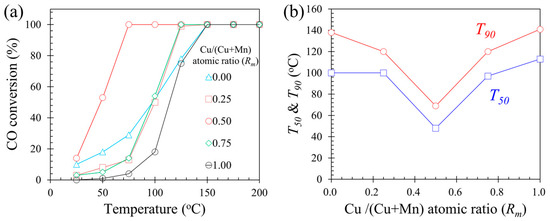
Figure 1.
(a) CO conversion on each catalyst as a function of reaction temperature. (b) T50 and T90 as a function of Cu/(Cu + Mn) atomic ratio (Rm).
Figure 2a–c show the effect of H2O (1%, 2%, or 5%) on CO oxidation on 0.5Cu–Mn2O4. CO conversion and CO2 selectivity decreased when increasing H2O concentration, indicating that H2O can influence CO oxidation. H2O (up to 5%) influence on CO conversion and CO2 selectivity can be eliminated at 150 °C (Figure 2d) and implies that the 0.5Cu–Mn2O4 catalyst has good water resistance performance above 150 °C.
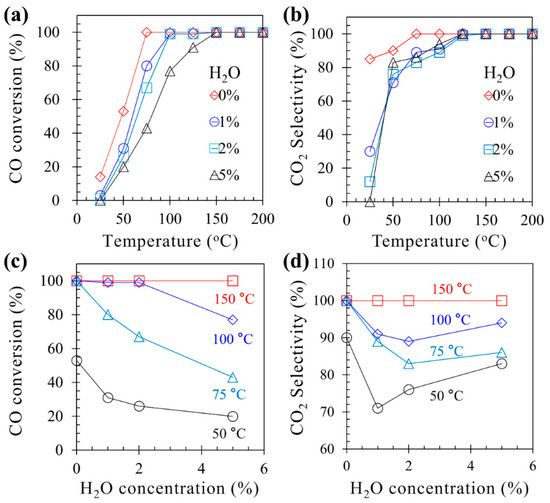
Figure 2.
Influence of H2O on CO conversion (a,c) and CO2 selectivity (b,d).
Figure S2 shows CO oxidation during a 10 h CO oxidation duration on 0.5Cu–Mn2O4 at 150 °C. CO conversion and CO2 selectivity of 0.5Cu–Mn2O4 were stable in all oxidation durations, and CO2 selectivity was close to 100%. This finding explored that the 0.5Cu–Mn2O4 catalyst had stable water-resistance performance.
2.2. Structural Properties
The XRD patterns of different catalysts are shown in Figure 3a. The diffraction peaks at 2θ = 30.4°, 37.5°, 43.5°, 57.6°, and 63.3° could be assigned to CuMn2O4 (PDF#74-2422) with spinel structure. Table 1 lists the structure parameters of Mn2O3, 0.5Cu–Mn2O4, and CuO catalysts. After Cu doping, the grain size decreased to 12.36 nm (0.5Cu–Mn2O4), significantly lower than 18.8 nm (CuO) and 27 nm (Mn2O3). The specific surface area of 0.5Cu–Mn2O4 was 56.22 m2 g−1, higher than those of Mn2O3 (24.44 m2 g−1) and CuO (15.70 m2 g−1). The peaks of 0.5Cu–Mn2O4 were flatter than those of Mn2O3 and CuO, suggesting that 0.5Cu–Mn2O4 had more defects and lower crystallinity than Mn2O3 and CuO.
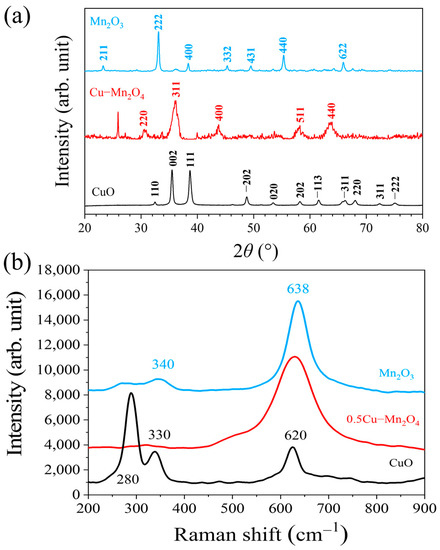
Figure 3.
XRD patterns (a) and Raman spectra (b) of Mn2O3, 0.5Cu–Mn2O4, and CuO.

Table 1.
Specific surfaces areas and pore properties of catalysts.
Raman spectra (Figure 3b) indicates that Mn2O3 and 0.5Cu–Mn2O4 had two peaks at 638 cm−1 and between 300 and 340 cm−1. The ratio of the peak intensities at 638 cm−1 to that at 300–340 cm−1 was used to quantify the oxygen vacancy defect (OVD) ratio on Mn2O3 and 0.5Cu–Mn2O4. The OVD ratio of 0.5Cu–Mn2O4 was 16.46%, higher than the 4.35% for Mn2O3 (Table 2). Three peaks at 280, 330, and 620 cm−1 corresponded to the vibration modes of Ag, B1g, and B2g of CuO, respectively [36].

Table 2.
Characterization results of each catalyst using XPS, ICP and Raman.
The N2 adsorption isotherms of Mn2O3, 0.5Cu–Mn2O4, and CuO are presented in Figure S3. Both Mn2O3 and 0.5Cu–Mn2O4 show Type III adsorption isotherms, while CuO shows Type IV adsorption isotherm. As listed in Table 1, the specific surface area and pore volume of 0.5Cu–Mn2O4 were higher than Mn2O3 and CuO, indicating that the Cu doping improved not only the structure but also crystallinity and defect, which could promote CO oxidation.
The metal element compositions of each catalyst were calculated using ICP-OES analysis results. The values of Rm, Rs-XPS, and Rb-ICP are shown in Table 2. When Rm was 0.5, Rb-ICP and Rs-XPS were 0.48 and 0.45, respectively; those three ratios were closed. The relationship of Rb-ICP and Rm (Figure S4) with a standard deviation (R2) of 0.9876 indicated that Cu could be successfully doped into Mn oxide with a mixing ratio of nitrate percussors. The successful doping was possibly due to the nitrate precursors of Cu and Mn being decomposed at a very closed temperature (Figure S5). For example, the temperature for 50% Mn(NO3)2 decomposition was 208 °C, close to that (245 °C) for Cu(NO3)2∙H2O.
Figure 4 shows the SEM images of Mn2O3, 0.5Cu–Mn2O4, and CuO. The catalysts had opened or closed hollow sphere morphologies with an outer diameter of 1–5 µm. The sphere walls of 0.5Cu–Mn2O4 were built up with many nano particles (about 10 nm), and those nano particles could be also found outside of the hollow spheres. This finding implies that the nano particles might be from the decomposition of nitrate percussor aerosols. During nitrate decomposition to oxide, NO2 gas was emitted, which possibly caused the nano particle accumulation to be hollow spheres.

Figure 4.
SEM morphologies of each catalyst.
Figure 5 presents the HRTEM images of Mn2O3, 0.5Cu–Mn2O4, and CuO. The (400) and (222) crystal planes of Mn2O3 [37], the (311) and (111) crystal planes of 0.5Cu–Mn2O4 [38], and the (111) crystal plane of CuO [39] could be confirmed.
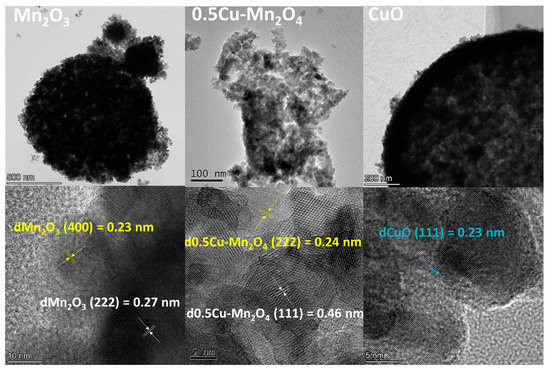
Figure 5.
HRTEM images of each catalyst.
The XPS spectra of Mn 2p3/2 of each catalyst are shown in Figure 6a, from which the valence state and ratio of Mn can be obtained [40]. Figure 6b shows the XPS spectra of Cu 2p3/2 of each catalyst, where the peaks at 932.52 and 934.06 eV belonged to Cu+ and Cu2+, respectively. Cu doping caused Mn4+ reduction to Mn3+, resulting in more Mn3+, which was conducive to the formation of oxygen vacancy defects [41]. Figure 6c shows the XPS spectra of O1s of each catalyst. The peaks of Oads (531.6 eV) and Olatt (529.5 eV) were related to the lattice and surface adsorbed oxygen atoms, respectively [42]. Table 2 summarizes the ratios of Mn3+/(Mn3+ + Mn4+), Cu+/(Cu+ + Cu2+), and Oads/(Oads + Olatt). The ratio of Oads/(Oads + Olatt) on 0.5Cu–Mn2O4 was 72%, larger than that of CuO and Mn2O3, indicating that 0.5Cu–Mn2O4 was rich in surface adsorbed oxygen.

Figure 6.
XPS spectra of Mn 2p3/2 (a), Cu 2p3/2 (b), and O1s (c).
Figure 7 shows the H2-TPR profiles of each catalyst. CuO had a wide peak at 320 °C, and Mn2O3 had two peaks at 245 and 370 °C. The catalyst 0.5Cu–Mn2O4 had two peaks at 165 and 200 °C. After Cu doping, the reduction peak shifted towards low temperature, indicating that a strong synergy between Mn and Cu contributed reactive oxygen species in the lattice and on the surface that could react with H2 at lower temperature.
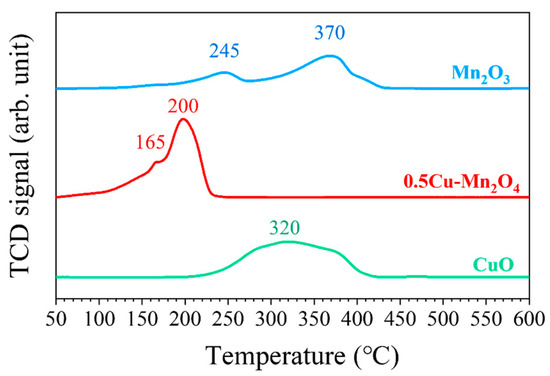
Figure 7.
H2-TPR profiles.
2.3. Operando DRIFTS-MS Spectra during CO Oxidation without Water
The DRIFTS spectra of CuO, 0.5Cu–Mn2O4, and Mn2O3 during CO oxidation from 25 °C to 400 °C with a ramp of 10 °C/min were observed (Figure 8a–c). The positive peak at 2360–2280 cm−1 was designated as CO2 [43]. The peak at 2150–2100 cm−1 belonged to CO adsorption (M-CO) [44]. The negative peaks at 1310–1260 cm−1 and 1240–1180 cm−1 were related to M=O (M=Cu, Mn) with terminal-type oxygen [45,46] and bicarbonate [47], respectively. The negative peak at 1022 cm−1 was contributed by M-O2− [45]. The negative peaks at 770 and 840 cm−1 were assigned to M-O-M with bridge-type oxygen [45,46] and M-O22− [48], respectively. Those peaks can be clearly observed from Figure 8b. Figure 8d illustrates CO2 MS signals during CO oxidation on CuO, 0.5Cu–Mn2O4, and Mn2O3. It was found that CO2 MS signal on 0.5Cu–Mn2O4 increased when the temperature was higher than 50 °C; this temperature was obviously lower than 125 °C on Mn2O3 and 150 °C on CuO. This finding clearly shows that 0.5Cu–Mn2O4 had better low-temperature CO oxidation activity than Mn2O3 and CuO.
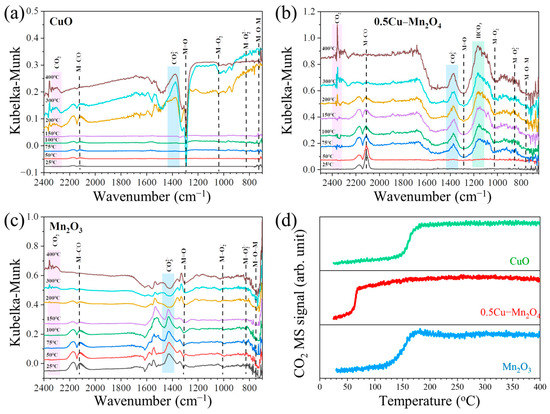
Figure 8.
Operando DRIFTS spectra during CO oxidation between 25 and 400 °C on CuO (a), 0.5Cu–Mn2O4 (b), and Mn2O3 (c). (d) CO2 MS signals at various temperatures.
Figure 9 gives the changes in heights of the main surface oxygen-related peaks as functions of temperature. M=O and M-O-M are the main surface oxygen atoms that contributed CO oxidation; M- is a descriptor of O2 adsorption at M sites with oxygen vacancies [45]. M=O and M-O-M on 0.5Cu–Mn2O4 decreased more rapidly than that on Mn2O3 and CuO due to M=O and M-O-M reacting with CO. The rapid decrease in M=O and M-O-M resulted in increase in M- and formation of oxygen vacancy (M-□-M, where, the oxygen vacancy is represented by an empty square □).

Figure 9.
Changes of peak heights of (a) M-O-M, (b) M=O, and (c) M- on each catalyst as functions of temperature.
2.4. Operando DRIFTS-MS Spectra during CO Oxidation with Water
Figure 2 demonstrated that water could influence CO oxidation when the reaction temperature was lower than 150 °C. Thus, the influence process was monitored using operando DRIFTS-MS during CO oxidation with water on 0.5Cu–Mn2O4 at fixed temperatures of 75 and 150 °C (Figure 10). The monitoring experiments were carried out by feeding a gas mixture of 1% CO and 20% O2 (balanced with Ar) in 0–30 and 61–90 min time durations and feeding a gas mixture of 1% CO, 1% H2O, and 20% O2 (balanced with Ar) in 31–60 min time durations. Figure 10a,c,e shows DRIFTS spectra, MS signals of CO2 and H2O, and surface species, respectively, where the reaction temperature was fixed at 75 °C. It can be confirmed that the CO2 MS signal decreased when the gas mixture with water was supplied, indicating that H2O has influence on CO oxidation. This fact was consistent with the results shown in Figure 2. When water was supplied, peak heights of surface H2O, M=O, and M-O-M increased, while M- decreased, suggesting that H2O could be adsorbed on the surface and inhibited CO adsorption, resulting in M=O and M-O-M not reacting with CO. This results also indicated that O2 decomposition on catalyst surface was not inhibited during CO oxidation with water, as O2 decomposition is the process for M=O and M-O-M formations [45].
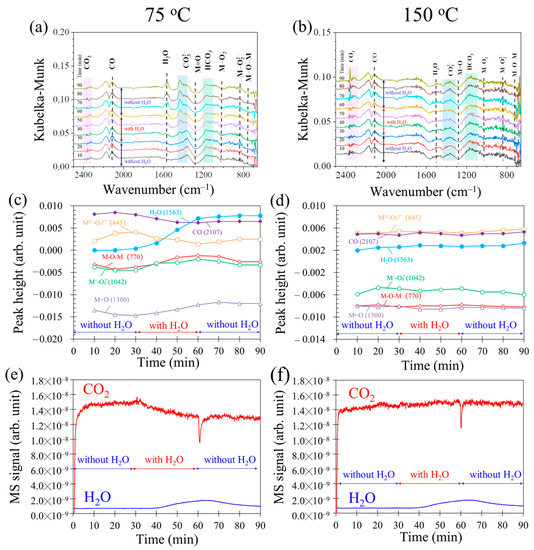
Figure 10.
DRIFTS-MS spectra during CO oxidation with water at 75 °C (a,c,e) and 150 °C (b,d,f).
3. Materials and Methods
3.1. Catalyst Preparation
The experimental setup for catalyst preparation is shown in Figure S1. A Pyrex bottle (500 mL) was filled with a 50 mL solution of copper nitrate trihydrate (Cu(NO3)2∙3H2O, Sinopharm Chem. Reagent, Shanghai, China) and manganese nitrate (Mn(NO3)2, Aladdin Reagent, Shanghai, China) and equipped with an ultrasonic atomizer (ZP-01, Chenyang Electric Appliance, Zhongshan, China) that was used to generate nitrate mists. The nitrate mists together with N2 gas (1 L/min) were heated to 60 °C in a Teflon tube to generate nitrate aerosols that flowed into a quartz tube (12 od. × 10 id. × 350 l. mm3) hold at 500 °C with the use of a tubular electric furnace (KSL-6D-11, Shandong Longkou Xianke, Longkou, China). The nitrate aerosols were decomposed to Cu-doped Mn oxide and collected with two water absorption bottles. The Cu-doped Mn oxide particles were separated from the water using high-speed centrifugation (TG16-WS, Liangyou Instrument, Changzhou, China) operated at 10,000 rpm for 10 min. The precipitate of Cu-doped Mn oxide particles after centrifugation was washed with pure water 3 times and dried at 80 °C for 12 h. The atomic ratio of Cu/(Cu + Mn) (Rm) was 0.00, 0.25, 0.5, 0.75, and 1.00 by controlling the amounts of manganese nitrate and copper nitrate in the solution. The obtained particle catalysts were designated Mn2O3, 0.25Cu–MnxOy, 0.5Cu–Mn2O4, 0.75Cu–MnxOy, and CuO, respectively.
3.2. Evaluation of Catalyst Activity
CO oxidation on each catalyst was evaluated using a fixed-bed tubular quartz reactor (10 od. × 4 id. × 350 l. mm3). The fixed bed (8 mm height) was filled with 100 mg of the catalyst. The reactor was fed with a gas mixture of 1% CO, 20% O2, and N2 balanced with a total gas flow rate of 50 mL/min with a weight hourly space velocity of 30,000 mL g−1 h−1. The concentrations of CO and CO2 in the gas mixture at the inlet or outlet of the reactor were analyzed online using a chromatograph (GC9790, Zhejiang Fuli, Taizhou, China).
The water resistance of the best catalyst (0.5Cu–Mn2O4) was demonstrated using a gas mixture containing 1% CO, 20% O2 (1%, 2%, or 5%), H2O, and N2 balance with a total gas flow rate of 50 mL min−1.
A 10 h long-term CO oxidation on the 0.5Cu–Mn2O4 catalyst was conducted using a fixed reaction temperature of 150 °C to evaluate water-resistance stability using a gas mixture containing 1% CO, 20% O2, 5% H2O, and N2 balance with a total gas flow rate of 50 mL min−1.
It must be noted that volumetric concentrations of all compositions in the gas mixtures were used.
3.3. Catalyst Characterization and Calculations
The crystalline structures were examined using an XRD (D/MAX2500, Japan) with a Cu-Kα radiation (λ = 0.15418 nm) at 40 kV and 40 mA. Raman spectra in 200–700 cm−1 were obtained using Horiba Scientific LabRAM HR Evolution with laser excitation of λ = 532 nm.
The N2 adsorption–desorption isotherms were collected at −196 °C using the specific surface and porosity analyzer (Autosorb-iQ2, Conta, Gainesville, GA, USA). The Brunauer–Emmett–Teller (BET) method was used to calculate the specific surface area. Pore diameter and pore volume were obtained using Barrett–Joyner–Halenda (BJH) analysis.
The metal element compositions were analyzed using the ICP-OES/MS (5110 ICP-OES, Agilent, Santa Clara, CA, USA).
The SEM and HRTEM images were taken using Regulus 8100 (Hitachi, Tokyo, Japan) and FEI Talos F200S (Thermo Scientific, St. Louis, MO, USA), respectively.
The XPS analysis was performed using Thermo Scientific K-Alpha (St. Louis, MO, USA) with Al-Kα X-ray radiation (hv = 1486.6 eV) as the excitation source. The observed elemental spectra were corrected by using a C 1s binding energy of 284.8 eV.
The H2-TPR measurement was carried out using an automatic temperature programmed chemistry analyzer (AutoChem II 2920, Micromeritics, Norcross, GA, USA). An amount of 30–40 mg catalyst powder was placed in a U-shaped quartz tube. The catalyst powders were pretreated from room temperature to 300 °C with a ramp of 10 °C min−1 in He atmosphere (50 mL min−1) for 1 h, cooled down to 50 °C, and supplied with 10% H2 (Ar balance) gas (50 mL min−1) for 0.5 h, heated to 700 °C with a rate of 10 °C min−1 in10% H2 (Ar balance) gas (50 mL min−1). The gas from the outlet of the quartz tube was detected with a thermal conductivity detector (TCD).
The DRIFTS-MS experiments were carried out as follows. The catalyst powders (about 30 mg) in the sample cell of the DRIFTS were pretreated in Ar (20 mL/min) at 300 °C for 1 h, cooled to room temperature (25 °C), and stabilized for 10 min, and then the background spectrum was collected. The sample cell was supplied with a gas mixture (1% CO, 20% O2, Ar balance, 20 mL min−1) for stabilization (20 min) and heated from 25 to 400 °C with a ramp of 10 °C min−1. Series software was used to collect the spectra at corresponding temperatures. Thirty-two scans were performed with a resolution of 4 cm−1, and the spectrum data of DRIFTS were analyzed using OMNIC software (IS 50 OMNIC 9.9 SPECTA 2.2 SERIES) during collection. The Kubelka–Munk function was used to convert the collected spectra into absorption spectra, whose intensities were linearly related to the amount of adsorbed functional group-related species. The gas from the sample cell was analyzed online using a mass spectrometer (MS) to obtain signals of CO (m/z = 28) and CO2 (m/z = 44).
When investigating the influence of water on CO oxidation at a fixed temperature (75 or 150 °C), water was added to the gas mixture to generate a gas mixture with water (1%H2O, 1% CO, 20% O2, Ar balance, 20 mL/min) and without water (1% CO, 20% O2, Ar balance, 20 mL min−1).
The thermal decomposition characteristics of manganese nitrate (Mn(NO3)2, Aladdin Reagent, Shanghai, China, 48.91 mg) and copper nitrate (Cu(NO3)2∙3H2O, 19.35 mg) in Ar atmosphere (30 mL min−1) were carried out by heating the nitrate from 25 to 1000 °C with a ramp of 10 °C min−1 using a thermogravimetric analyzer (TG, LABSYS evo TGA, Setaram, Caluire, France).
The CO conversion and CO2 selectivity were calculated using Equations (1) and (2), respectively.
where [CO]0 and [CO] are CO concentrations in the gas mixture from the inlet and outlet of the reactor, respectively.
Cu/(Cu + Mn) atomic ratio (Rm) in the nitrate solution for atomization was defined as the moles of Cu(NO3)2 to the total moles of Cu(NO3)2 and Mn(NO3)2.
Cu/(Cu + Mn) ratio (Rb-ICP) in each catalyst measured using the ICP-OES was defined using Equation (3).
where Ccu and CMn in mol/kg were obtained from ICP-OES analysis.
Cu/(Cu + Mn) ratio (Rs-XPS) on the surface of each catalyst was calculated using Equation (4).
where Wcu and WMn in the atom ratio were obtained from XPS analysis.
Oxygen vacancy defect (OVD) ratio was calculated from the Raman analysis results using the intensity of the peak at 638 cm−1 to that between 300 and 340 cm−1.
4. Conclusions
In this study, Cu-doped manganese oxide prepared using aerosol decomposition was used as a CO oxidation catalyst. The CO-oxidation and water-resistance performance were evaluated. DRIFTS-MS was used to investigate the mechanisms of CO oxidation and water resistance. The main results are summarized as follows:
- (1)
- The catalyst 0.5Cu–Mn2O4 of 0.48 Cu/(Cu + Mn) atomic ratio had the best CO oxidation performance. T50 and T90 were as low as 48 and 69 °C, respectively.
- (2)
- Cu could be successfully doped into Mn2O4 due to their nitrate precursors having closed thermal decomposition properties, which ensured the atomic ratio of Cu/(Cu + Mn) close to the atomic ratio in nitrate precursors.
- (3)
- The catalyst 0.5Cu–Mn2O4 had a hollow sphere morphology, and the sphere wall was composed of a large number of nanospheres (about 10 nm), yielding the largest specific surface area and the defects on the interfacing of the nanospheres.
- (4)
- The catalyst 0.5Cu–Mn2O4 had high Mn3+, Cu+, and Oads ratios, which facilitated oxygen vacancy formation, CO adsorption, and CO oxidation, respectively, which had a synergetic effect on CO oxidation.
- (5)
- Terminal-type oxygen (M=O) and bridge-type oxygen (M-O-M) on 0.5Cu–Mn2O4 were reactive at a low temperature, resulting in a good low-temperature CO oxidation performance.
- (6)
- Water could adsorb on 0.5Cu–Mn2O4 and inhibited M=O and M-O-M reaction with CO. Water could not inhibit O2 decomposition to M=O and M-O-M. The catalyst 0.5Cu–Mn2O4 had excellent water resistance at 150 °C at which the influence of water (up to 5%) on CO oxidation could be completely eliminated.
Supplementary Materials
The following supporting information can be downloaded at https://www.mdpi.com/article/10.3390/molecules28083511/s1. Figure S1, Diagram of catalyst preparation system. Figure S2, CO conversion (a) and CO2 selectivity (b) during 10-h CO oxidation on 0.5Cu–Mn2O4. Figure S3, N2 adsorption isotherms of Mn2O3, 0.5Cu–Mn2O4, and CuO. Figure S4, Relationship of atomic ratios of Cu/(Cu + Mn). Figure S5, Decomposition profiles of Mn(NO3)2 and Cu(NO3)2∙H2O.
Author Contributions
X.G., conceptualization, investigation, formal analysis, writing—original draft; J.X., T.Z., Y.S., S.F. and N.L., data curation; J.Z., methodology and investigation; Z.W. and J.L., methodology; E.G. and W.W., validation; S.Y., conceptualization, validation, revision, supervision, funding, and project administration. All authors have read and agreed to the published version of the manuscript.
Funding
This research was supported by the National Natural Science Foundation of China (Grant No. 12075037), the Postgraduate Research & Practice Innovation Program of Jiangsu Province (Grant No. SJCX21_1260), and the Research and Application Service Platform Project of API Manufacturing Environmental Protection and Safety Technology in China (Grant No. 2020-0107-3-1).
Institutional Review Board Statement
Not applicable.
Informed Consent Statement
Not applicable.
Data Availability Statement
The raw data are available from the corresponding author upon reasonable request.
Acknowledgments
All authors are grateful for the financial support of this work provided by the Natural Science Foundation, the Postgraduate Research & Practice Innovation Program of Jiangsu Province, and the Research and Application Service Platform Project of API Manufacturing Environmental Protection and Safety Technology in China.
Conflicts of Interest
The authors declare no conflict of interest.
Sample Availability
Samples of the catalysts are not available from the authors.
References
- Liu, S.; Liu, Y.; Yang, C.; Xie, D.; Zhang, X. Charcoal burning is associated with a higher risk of delayed neurological sequelae after domestic carbon monoxide poisoning in South China: A retrospective cohort study. Am. J. Emerg. Med. 2022, 60, 57–61. [Google Scholar] [CrossRef]
- Adach, W.; Błaszczyk, M.; Olas, B. Carbon monoxide and its donors—Chemical and biological properties. Chem. Biol. Interact. 2020, 318, 108973. [Google Scholar] [CrossRef]
- Yu, W.Z.; Wang, W.W.; Li, S.Q.; Fu, X.P.; Wang, X.; Wu, K.; Si, R.; Ma, C.; Jia, C.J.; Yan, C.H. Construction of active site in a sintered copper-ceria nanorod catalyst. J. Am. Chem. Soc. 2019, 141, 17548–17557. [Google Scholar] [CrossRef] [PubMed]
- Xiao, M.; Zhang, X.; Yang, Y.; Cui, X.; Chen, T.; Wang, Y. M (M = Mn, Co, Cu)-CeO2 catalysts to enhance their CO catalytic oxidation at a low temperature: Synergistic effects of the interaction between Ce3+-Mx+-Ce4+ and the oxygen vacancy defects. Fuel 2022, 323, 124379. [Google Scholar] [CrossRef]
- Xu, K.; Wang, Z.; He, C.; Ruan, S.; Liu, F.; Zhang, L. Flame in situ synthesis of metal-anchored CuO nanowires for CO catalytic oxidation and kinetic analysis. ACS Appl. Energy Mater. 2021, 4, 13226–13238. [Google Scholar] [CrossRef]
- Li, L.; Feng, X.; Nie, Y.; Chen, S.; Shi, F.; Xiong, K.; Ding, W.; Qi, X.; Hu, J.; Wei, Z.; et al. Insight into the effect of oxygen vacancy concentration on the catalytic performance of MnO2. ACS Catal. 2015, 5, 4825–4832. [Google Scholar] [CrossRef]
- Luo, M.F.; Zhong, Y.J.; Yuan, X.X.; Zheng, X.M. TPR and TPD studies of CuO/CeO2 catalysts for low temperature CO oxidation. Appl. Catal. A Gen. 1997, 162, 121–131. [Google Scholar] [CrossRef]
- Wintterlin, J.; Völkening, S.; Janssens, T.V.W.; Zambelli, T.; Ertl, G. Atomic and macroscopic reaction rates of a surface-catalyzed reaction. Science 1997, 278, 1931–1934. [Google Scholar] [CrossRef]
- Alavi, A.; Hu, P.; Deutsch, T.; Silvestrelli, P.L.; Hutter, J. CO oxidation on Pt(111): An ab initio density functional theory study. Phys. Rev. Lett. 1998, 80, 3650–3653. [Google Scholar] [CrossRef]
- Allian, A.D.; Takanabe, K.; Fujdala, K.L.; Hao, X.; Truex, T.J.; Cai, J.; Buda, C.; Neurock, M.; Iglesia, E. Chemisorption of CO and mechanism of CO oxidation on supported platinum nanoclusters. J. Am. Chem. Soc. 2011, 133, 4498–4517. [Google Scholar] [CrossRef]
- Arán-Ais, R.M.; Vidal-Iglesias, F.J.; Farias, M.J.S.; Solla-Gullón, J.; Montiel, V.; Herrero, E.; Feliu, J.M. Understanding CO oxidation reaction on platinum nanoparticles. J. Electroanal. Chem. 2017, 793, 126–136. [Google Scholar] [CrossRef]
- L’vov, B.V.; Galwey, A.K. Catalytic oxidation of CO on platinum: Thermochemical approach. J. Therm. Anal. Calorim. 2013, 111, 145–154. [Google Scholar] [CrossRef]
- Kim, J.; Noh, M.C.; Doh, W.H.; Park, J.Y. In situ observation of competitive CO and O2 adsorption on the Pt(111) surface using near-ambient pressure scanning tunneling microscopy. J. Phys. Chem. C 2018, 122, 6246–6254. [Google Scholar] [CrossRef]
- Vogel, D.; Spiel, C.; Suchorski, Y.; Trinchero, A.; Schlögl, R.; Grönbeck, H.; Rupprechter, G. Local catalytic ignition during CO oxidation on low-index Pt and Pd surfaces: A combined PEEM, MS, and DFT study. Angew. Chem. Int. Edit. 2012, 51, 10041–10044. [Google Scholar] [CrossRef] [PubMed]
- Newton, M.A.; Ferri, D.; Smolentsev, G.; Marchionni, V.; Nachtegaal, M. Room- temperature carbon monoxide oxidation by oxygen over Pt/Al2O3 mediated by reactive platinum carbonates. Nat. Commun. 2015, 6, 8675. [Google Scholar] [CrossRef]
- An, N.; Yuan, X.; Pan, B.; Li, Q.; Li, S.; Zhang, W. Design of a highly active Pt/Al2O3 catalyst for low-temperature CO oxidation. RSC Adv. 2014, 4, 38250–38257. [Google Scholar] [CrossRef]
- Dong, C.; Zong, X.; Jiang, W.; Niu, L.; Liu, Z.; Qu, D.; Wang, X.; Sun, Z. Recent advances of ceria-based materials in the oxidation of carbon monoxide. Small Struct. 2021, 2, 2000081. [Google Scholar] [CrossRef]
- Jiang, D.; Wan, G.; García Vargas, C.E.; Li, L.; Pereira-Hernández, X.I.; Wang, C.; Wang, Y. Elucidation of the active sites in single-atom Pd1/CeO2 catalysts for low-temperature CO oxidation. ACS Catal. 2020, 10, 11356–11364. [Google Scholar] [CrossRef]
- Wang, J.; Chen, H.; Hu, Z.; Yao, M.; Li, Y. A review on the Pd-based three-way catalyst. Catal. Rev. 2015, 57, 79–144. [Google Scholar] [CrossRef]
- Lambert, C.K. Current state of the art and future needs for automotive exhaust catalysis. Nat. Catal. 2019, 2, 554–557. [Google Scholar] [CrossRef]
- Landon, P.; Ferguson, J.; Solsona, B.E.; Garcia, T.; Al-Sayari, S.; Carley, A.F.; Herzing, A.A.; Kiely, C.J.; Makkee, M.; Moulijn, J.A.; et al. Selective oxidation of CO in the presence of H2, H2O and CO2 utilising Au/α-Fe2O3 catalysts for use in fuel cells. J. Mater. Chem. 2006, 16, 199–208. [Google Scholar] [CrossRef]
- Wang, M.; Ma, P.; Wu, Z.; Chu, S.; Zheng, Y.; Zhou, Z.; Weng, W. Evolution of Pd chemical states and effects of C3H6 and H2O on the CO oxidation over Pd/CeO2 catalyst. Appl. Surf. Sci. 2022, 599, 153897. [Google Scholar] [CrossRef]
- Haruta, M.; Yamada, N.; Kobayashi, T.; Iijima, S. Gold catalysts prepared by coprecipitation for low-temperature oxidation of hydrogen and of carbon monoxide. J. Catal. 1989, 115, 301–309. [Google Scholar] [CrossRef]
- Qiao, B.; Wang, A.; Yang, X.; Allard, L.F.; Jiang, Z.; Cui, Y.; Liu, J.; Li, J.; Zhang, T. Single-atom catalysis of CO oxidation using Pt1/FeOx. Nat. Chem. 2011, 3, 634–641. [Google Scholar] [CrossRef]
- Kang, Y.; Sun, M.; Li, A. Studies of the catalytic oxidation of CO over Ag/CeO2 catalyst. Catal. Lett. 2012, 142, 1498–1504. [Google Scholar] [CrossRef]
- Huang, M.; Zhao, X.L.; Li, F.; Zhang, L.L.; Zhang, Y.X. Facile synthesis of ultrathin manganese dioxide nanosheets arrays on nickel foam as advanced binder-free supercapacitor electrodes. J. Power Sources 2015, 277, 36–43. [Google Scholar] [CrossRef]
- Rong, S.; Li, K.; Zhang, P.; Liu, F.; Zhang, J. Potassium associated manganese vacancy in birnessite-type manganese dioxide for airborne formaldehyde oxidation. Catal. Sci. Technol. 2018, 8, 1799–1812. [Google Scholar] [CrossRef]
- Abad, A.; Adánez, J.; García-Labiano, F.; de Diego, L.F.; Gayán, P.; Celaya, J. Mapping of the range of operational conditions for Cu-, Fe-, and Ni-based oxygen carriers in chemical-looping combustion. Chem. Eng. Sci. 2007, 62, 533–549. [Google Scholar] [CrossRef]
- Xu, L.; Edland, R.; Li, Z.; Leion, H.; Zhao, D.; Cai, N. Cu-modified manganese ore as an oxygen carrier for chemical looping combustion. Energy Fuels 2014, 28, 7085–7092. [Google Scholar] [CrossRef]
- Wang, K.; Yu, Q.; van Sint Annaland, M.; Wu, T.; Qin, Q. Improvement of the oxygen uncoupling properties of copper-based composite oxygen carriers for chemical looping air separation. Energy Fuels 2020, 34, 3449–3457. [Google Scholar] [CrossRef]
- Zhang, X.; Li, H.; Yang, Y.; Zhang, T.; Wen, X.; Liu, N.; Wang, D. Facile synthesis of new efficient Cu/MnO2 catalysts from used battery for CO oxidation. J. Environ. Chem. Eng. 2017, 5, 5179–5186. [Google Scholar] [CrossRef]
- Gao, J.; Jia, C.; Zhang, L.; Wang, H.; Yang, Y.; Hung, S.F.; Hsu, Y.Y.; Liu, B. Tuning chemical bonding of MnO2 through transition-metal doping for enhanced CO oxidation. J. Catal. 2016, 341, 82–90. [Google Scholar] [CrossRef]
- Kong, M.; Li, Y.; Chen, X.; Tian, T.; Fang, P.; Zheng, F.; Zhao, X. Tuning the relative concentration ratio of bulk defects to surface defects in TiO2 nanocrystals leads to high photocatalytic efficiency. J. Am. Chem. Soc. 2011, 133, 16414–16417. [Google Scholar] [CrossRef]
- Zhu, L.; Wang, J.; Rong, S.; Wang, H.; Zhang, P. Cerium modified birnessite-type MnO2 for gaseous formaldehyde oxidation at low temperature. Appl. Catal. B Environ. 2017, 211, 212–221. [Google Scholar] [CrossRef]
- Dong, C.; Qu, Z.; Jiang, X.; Ren, Y. Tuning oxygen vacancy concentration of MnO2 through metal doping for improved toluene oxidation. J. Haz. Mat. 2020, 391, 122181. [Google Scholar] [CrossRef]
- Wang, Q.; Li, Z.; Banares, M.A.; Weng, L.T.; Gu, Q.; Price, J.; Han, W.; Yeung, K.L. A novel approach to high-performance aliovalent-substituted catalysts-2D bimetallic MOF-derived CeCuO(x) microsheets. Small 2019, 15, 1903525. [Google Scholar] [CrossRef]
- Yang, Y.; Si, W.; Peng, Y.; Wang, Y.; Liu, H.; Su, Z.; Li, J. Defect engineering on CuMn2O4 spinel surface: A new path to high-performance oxidation catalysts. Environ. Sci. Technol. 2022, 56, 16249–16258. [Google Scholar] [CrossRef]
- Tang, W.; Wu, X.; Li, S.; Shan, X.; Liu, G.; Chen, Y. Co-nanocasting synthesis of mesoporous Cu–Mn composite oxides and their promoted catalytic activities for gaseous benzene removal. Appl. Catal. B Environ. 2015, 162, 110–121. [Google Scholar] [CrossRef]
- Zhang, X.; Tian, P.; Tu, W.; Zhang, Z.; Xu, J.; Han, Y.F. Tuning the dynamic interfacial structure of copper–ceria catalysts by indium oxide during CO Oxidation. ACS Catal. 2018, 8, 5261–5275. [Google Scholar] [CrossRef]
- Zhang, C.; Xie, A.; Zhang, W.; Chang, J.; Liu, C.; Gu, L.; Duo, X.; Pan, F.; Luo, S. CuMn2O4 spinel anchored on graphene nanosheets as a novel electrode material for supercapacitor. J. Energy Storage 2021, 34, 102181. [Google Scholar] [CrossRef]
- Yuan, X.; Qing, M.; Meng, L.; Zhao, H. One-step synthesis of nanostructured Cu–Mn/TiO2 via flame spray pyrolysis: Application to catalytic combustion of CO and CH4. Energ. Fuels 2020, 34, 14447–14457. [Google Scholar] [CrossRef]
- Fang, R.; Liu, F.; Liu, J.; Li, Y. Experimental and theoretical insights into the reaction mechanism of spinel CuMn2O4 with CO in chemical-looping combustion. Appl. Surf. Sci. 2021, 561, 150065. [Google Scholar] [CrossRef]
- Meng, M.; Liu, Y.; Sun, Z.; Zhang, L.; Wang, X. Synthesis of highly-dispersed CuO–CeO2 catalyst through a chemisorption-hydrolysis route for CO preferential oxidation in H2-rich stream. Int. J. Hydrogen Energ. 2012, 37, 14133–14142. [Google Scholar] [CrossRef]
- Chen, Y.; Liu, Y.; Mao, D.; Yu, J.; Zheng, Y.; Guo, X.; Ma, Z. Facile cyclodextrin-assisted synthesis of highly active CuO-CeO2/MCF catalyst for CO oxidation. J. Taiwan Inst. Chem. E 2020, 113, 16–26. [Google Scholar] [CrossRef]
- Xu, J.; Zhang, T.; Fang, S.; Li, J.; Wu, Z.; Wang, W.; Zhu, J.; Gao, E.; Yao, S. Exploring the roles of oxygen species in H2 oxidation at β-MnO2 surfaces using operando DRIFTS-MS. Comm. Chem. 2022, 5, 97. [Google Scholar] [CrossRef]
- Wu, J.; Su, T.; Jiang, Y.; Xie, X.; Qin, Z.; Ji, H. In situ DRIFTS study of O3 adsorption on CaO, γ-Al2O3, CuO, α-Fe2O3 and ZnO at room temperature for the catalytic ozonation of cinnamaldehyde. Appl. Surf. Sci. 2017, 412, 290–305. [Google Scholar] [CrossRef]
- Pu, Y.; Luo, Y.; Wei, X.; Sun, J.; Li, L.; Zou, W.; Dong, L. Synergistic effects of Cu2O-decorated CeO2 on photocatalytic CO2 reduction: Surface Lewis acid/base and oxygen defect. Appl. Catal. B Environ. 2019, 254, 580–586. [Google Scholar] [CrossRef]
- Che, M.; Tench, A.J. Characterization and reactivity of molecular oxygen species on oxide surfaces. Adv. Catal. 1983, 32, 1–148. [Google Scholar] [CrossRef]
Disclaimer/Publisher’s Note: The statements, opinions and data contained in all publications are solely those of the individual author(s) and contributor(s) and not of MDPI and/or the editor(s). MDPI and/or the editor(s) disclaim responsibility for any injury to people or property resulting from any ideas, methods, instructions or products referred to in the content. |
© 2023 by the authors. Licensee MDPI, Basel, Switzerland. This article is an open access article distributed under the terms and conditions of the Creative Commons Attribution (CC BY) license (https://creativecommons.org/licenses/by/4.0/).